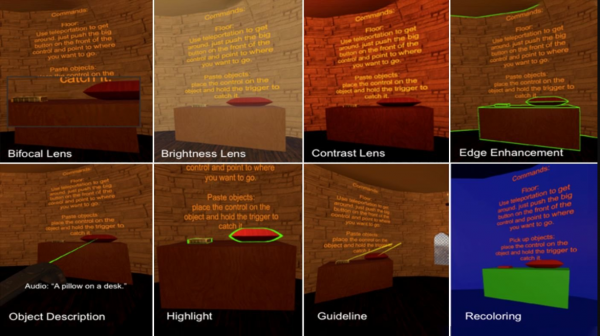Microsoft’s SeeingVR Tools Helping People with Vision Problems View Unity VR Apps
On paper, virtual reality headsets shouldn’t pose a problem for people with vision problems. The screens are up-close and have a very high degree of contrast along with lenses that have been personally calibrated which should enable people, even those with poor vision, to see very fine details including those that you would normally miss when staring at the “real world” with naked eyes.
However, in spite of the hardware advantage, virtual reality software is not generally optimized for people with lower vision so that sort of downgrades the VR experience for people with poor vision. It is also exacerbated by the fact that very few VR hardware are glasses-friendly. In fact, most of the leading premium brands aren’t prescription glasses-friendly at all.
Microsoft is trying to solve this through a solution called SeeingVR, a toolkit designed for Unity VR app and game developers to incorporate accessibility features that cater to people with poor vision.

Not all users have vision problems so the researchers at Microsoft chose to go with a toolkit approach where the individual players are able to customize a personal experience that corresponds to their individual vision problems. The SeeingVR toolkit consists of a total of 14 tools that include a magnifier, depth measurements, controls that can be used to adjust for contrast and brightness, edge enhancement and a bifocal lens for window pane-like features. Developers on the Unity VR platform will also be able to create visual guidelines, highlight objects or to recolor scenes and enhance them for users with poor vision. The toolkit even allows text to be augmented and converted into speech or to be applied in the description of objects.
Players with poor vision can choose to have objects within a scene read out aloud or described so that they can get better a perception of scenes where their vision fails them.
The SeeingVR toolkit has been tested on 11 people with vision problems and the Microsoft researchers found that all the subjects were able to finish diverse tasks such as menu selection or shooting much faster with the tool than in the default mode. Currently, the SeeingVR toolkit is available only for Unity VR developers but the new tech could see widespread adoption as the Unity VR platform happens to be one of the biggest virtual reality development platforms.
The enhancement and selections tools in SeeingVR are not too complicated and should be fairly familiar to developers who are used to operating system-level accessibility tools. However, some of SeeingVR features are unique to the toolkit. Such is the case with the depth measurement feature that enables users that have poor sight in one eye to determine the distance. There is another feature that allows users to use “peripheral mapping” to create more focused tunnel vision. Another feature of the toolkit, “Seeing AI”, tries to perceive and describe features in its field of view where there is no developer description. It also offers the option to add descriptions.
Unity developers don’t have to do any special recoding with most of the tools in the SeeingVR toolkit. They will be able to simply activate them or turn them off just like you’d do with filters. This can be performed individually or in combination with other tools. However, there are certain tools that will require minor app modifications in order to provide adequate support. Microsoft’s small-scale testing has suggested that the app has had a positive impact on low vision users enabling them to perform tasks much faster and more efficiently.
The SeeingVR toolkit will be formally presented in May along with a research paper on the same titled “SeeingVR: A Set of Tools to Make Virtual Reality More Accessible to People with Low Vision” during the CHI 2019 conference in Scotland. During the presentation, the researchers will also explore opportunities on how to improve accessibility to web content for users who are dyslexic, mainly via the existing “reading modes” of web browsers and other options for making both virtual reality and non-VR educational content accessible to users who are legally blind.
https://virtualrealitytimes.com/2019/04/19/microsofts-seeingvr-tools-helping-people-with-vision-problems-view-unity-vr-apps/https://virtualrealitytimes.com/wp-content/uploads/2019/04/SeeingVR-bifocals-mode-600x317.jpghttps://virtualrealitytimes.com/wp-content/uploads/2019/04/SeeingVR-bifocals-mode-150x90.jpgInventionsOn paper, virtual reality headsets shouldn’t pose a problem for people with vision problems. The screens are up-close and have a very high degree of contrast along with lenses that have been personally calibrated which should enable people, even those with poor vision, to see very fine details including...Sam OchanjiSam Ochanji[email protected]EditorVirtual Reality Times - Metaverse & VR

